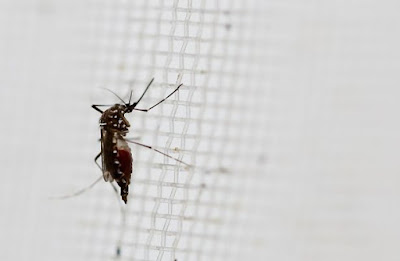Scientists have warned that panspermia - the theory of genetic material raining down from space - could make Zika stronger and more deadly
Genetic material falling on Earth from outer space could create a supercharged version of the Zika virus, scientists have warned.
Experts claim that the virus, which is spreading across the globe, will become more prevalent and deadly in the future.
Changes in Zika have already been noted, as it's changed to be passable through sexual contact.
The disease, first discovered in monkeys in 1947, had previously only been transferable by mosquito bite.
But now, scientists are warning that it could mutate, growing stronger and spreading more easily - with its victims suffering more serious consequences.
Read more: Zika virus 'may cause rare neurological disorder that can paralyse and KILL'
They have warned that future strains could become worse thanks to panspermia - the theory of genetic material constantly raining down on Earth from outer space.
Dangerous insect: A female Aedes aegypti mosquito which has been at the centre of the spread of the Zika virus
This could be the reason the virus has in the past couple of months developed the ability to spread via sexual contact, experts say.
Professor Chandra Wickramasinghe, of the University of Buckingham, has long held panspermia as a common route of viral and bacterial mutation.
Worryingly, he said, is the apparent ability of the Zika virus to pick up foreign DNA and adapt quickly to become more virulent.
Science fact: Milton Wainwright investigated panspermia, which he says is genetic material raining down on Earth from space
Once taken up by the killer germ - which causes fever, rash and sometimes death - this piece of genetic code can mutate further making it more dangerous.
Professor Wickramasinghe said: "We believe this has already happened with the Zika virus.
"This we have seen by its sudden ability to be passed on by sexual contact suggesting it has taken up an entirely new piece of genetic code.
Space dust: Milton Wainwright's alien DNA as collected by a balloon sent into the stratosphere
"The virus replicates and makes further copies of itself, with each time there is an opportunity for a mistake or change to be made in this sequence.
"This will add new characteristics to the virus, and it will keep happening as the virus evolves.
"It could certainly become more easily transmissible with dramatic changes to its characteristics."
Unmanned mission: Launch of Milton Wainwright's balloon into the stratosphere to collect space dust
Zika is not the only infectious pathogen thought to be altered by panspermia with sudden outbreaks of disease blamed on the phenomenon.
Professor Wickramasinghe said the current crisis shows terrifying signs of escalating out of control and even threatening the future of humanity.
He said: "Evidence is mounting that through this process benign viruses and bacteria have the potential to become harmful.
"It is not just the Zika virus, there are more viruses on the planet than any other living creature and these could all could be affected.
"Unless this is taken seriously the future of humanity is threatened."
Cure sought: An aedes aegypti mosquitoes is seen in The Gorgas Memorial institute for Health Studies laboratory
Some scientists believe panspermia is in continual action with reams of alien DNA showering down from space.
Previous research by Professor Milton Wainwright and his team at the University of Sheffield and the University of Buckingham Centre for Astrobiology appears to back the theory.
Professor Wainwright sent balloons into the stratosphere where dust allowed to settle on their surface was shown to contain genetic material.
He said collection equipment was sent high enough above the atmosphere for it to impossible for this DNA to have originated from Earth.
Tiny dents made on the balloons were deep enough to conclude they must have fallen from much further out in space.
Baby problems: Rosana Vieira Alves bathes her 4-month-old daughter Luana Vieira, who was born with microcephaly
Professor Wainwright has previously isolated mysterious life-like forms including the ghost particle, dragon particle and a strange metallic sphere believed to be a seed.
"On hitting the stratosphere sampler the sphere made an impact crater, a minute version of the huge impact crater on Earth caused by the asteroid said to have killed off the dinosaurs.
"This impact crater proves that the sphere was incoming to Earth from space, an organism coming from Earth would not be travelling fast enough when it fell back to Earth to cause such damage.
"This seems never before to have been found on Earth."
Professor Edward Steele, biologist and immunologist the CY O'Connor ERADE Village Foundation in Australia said: "Over the past two decades there has been a growing recognition that horizontal gene transfer, via the agency of viruses, might play a key role in evolution.
"The process of horizontal gene transfer should be extended well outside our planets biosphere. With current estimates of over 100 billion habitable planets in our galaxy alone such an extension, admitting the concepts of panspermia, would seem entirely reasonable.
"Over the past decade there has been growing evidence for microorganisms currently entering the stratosphere of the Earth.
Ignoring this possibility of a continuing input of microbial and viral genes to the Earth from the external universe might be fraught with imminent danger.
Credit: Mirror







No comments:
Post a Comment